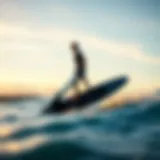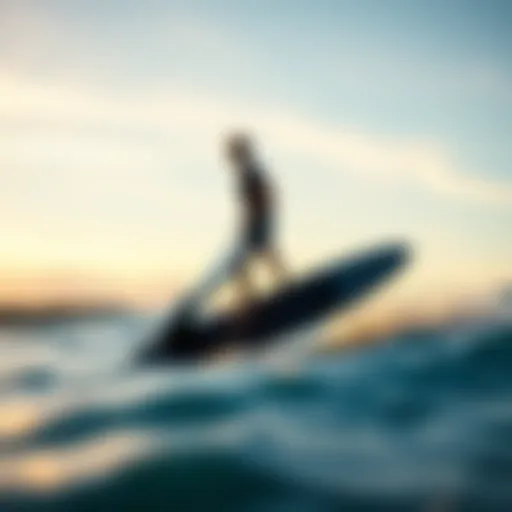Top Longboards for Every Skater: A Detailed Guide
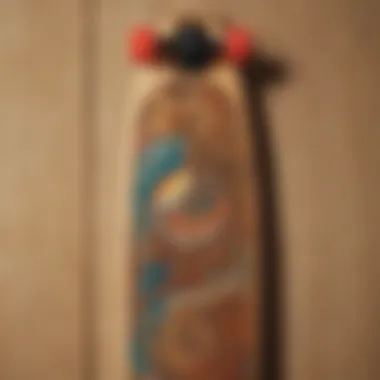

Intro
There’s more to longboarding than just hitting the pavement. Like an artist with a canvas, a skilled longboarder carves their unique path through the world, embracing a blend of style and functionality. This guide aims to provide a comprehensive insight into the best skateboard longboards on the market.
Longboards have become a staple in skate culture, transcending mere transportation to shape personal expression and lifestyle choices. Whether you’re a rookie looking to ride your first board or a seasoned enthusiast honing your skills, understanding the variety of longboards available is crucial.
Though some may argue that all longboards is the same, the truth is that they cater to a spectrum of riding styles, from cruising to downhill racing. Different types of longboards serve different purposes, and knowing these nuances can greatly enhance your skating experience.
In this article, we will explore essential features to consider when selecting a longboard, delve into the characteristics of various riding styles, and provide tailored recommendations.
We’ll also touch on how to maintain your longboard, draw comparisons with traditional skateboards, and provide a glimpse into the evolving longboarding culture. By the time you've finished reading, you'll not only grasp the intricacies of what defines an exemplary longboard but also feel equipped to make decisions that align with your riding aspirations.
Understanding Longboards and Their Purpose
When diving into the world of skating, understanding longboards and their purpose is crucial for enthusiasts. Longboarding transcends mere recreational activity; it’s a unique blend of sport, art, and lifestyle. The way longboards are designed caters specifically to various riding techniques, making them significant for many individuals, whether they're commuting or cruising down scenic paths.
Fundamentals of Longboarding
Longboarding is more than just an extended skateboard. One of its main appeals lies in the shape and size of the board, which directly impacts the ride and control. A longboard typically measures around 33 to 60 inches, providing not just room for stability but also a smooth glide that skateboarders often crave.
The fundamentals focus on how the design influences the board’s purpose: cruising, carving, downhill rides, or just enjoying leisurely rides around town.
Its larger wheels and softer materials absorb shocks better, offering ride quality that can’t be easily matched by traditional skateboards. This means fewer bumps in your ride, especially useful for those who find themselves traversing over rougher terrains.
Difference Between Skateboards and Longboards
Although both longboards and skateboards share common roots, they often take distinct paths when it comes to design and functionality. Longboards are generally more elongated and flexible, primarily crafted for stability and cruising rather than switching tricks. In contrast, traditional skateboards are shorter and more rigid, suited for tricks and vertical movements on ramps.
- Length and Flexibility
Longboards can be much longer than skateboards, which facilitates a different riding style. The flexibility in longboards contributes to a smoother ride, particularly when carving or cruising. - Wheels and Trucks
Longboards often feature larger wheels that roll over surfaces more effectively, while skateboards use smaller wheels, which support more technical maneuvers. Also, truck designs differ significantly, as longboards emphasize stability. - Intended Use
While skateboards are tailored for tricks, longboards allow for a different experience focused on speed and distance.
Understanding these distinctions is essential as it influences not just preferences in riding but also the effectiveness of the board based on the environment and purpose. Equipped with this knowledge, riders can make better choices tailored to their longboarding aspirations.
Types of Longboards
Understanding the variety in longboards isn't just an academic exercise; it's vital for anyone looking to dive into longboarding. Each type of longboard serves a different purpose, accompanying different styles and needs. Whether you're a laid-back cruiser or an adrenaline-seeking downhill rider, knowing these variations can elevate your ride and make the experience more enjoyable.
Cruising Longboards
Cruising longboards, as the name suggests, are designed for leisurely rides and smooth gliding. They typically come with wider decks that offer stability, making them ideal for city commutes or casual rides along the boardwalk. The wheelbase is usually longer, enhancing balance and comfort while enabling riders to navigate through crowded urban environments without much hassle.
One critical aspect of cruising longboards is their wheel size and softness. Larger wheels (around 65mm to 75mm) with a lower durometer provide a smoother ride over bumps and cracks in the pavement. These boards are perfect for anyone who enjoys a relaxed ride while soaking in the scenery.
When selecting a cruising longboard, consider the design, as some might favor aesthetics and style over functionality. Although cruising is a range without much technical requirement, it is essential to find a board that reflects your personal taste while serving its purpose well.
Freeride Longboards
If you’re a rider who enjoys showing off tricks while still keeping it simple, then freeride longboards are your best bet. These boards are more versatile, allowing for sliding, carving, and even occasional downhill use. The designs often feature symmetrical shapes, making it easier to ride both ways—perfect for executing those gnarly slides.
Freeride boards typically have a medium-sized wheelbase, allowing enough stability while maintaining maneuverability. The wheel durometer tends to be higher, providing necessary grip when carving and sliding, but can also slide smoothly when you want to bust some tricks on a populated parking lot.
The kicker here is the versatility—freeride boards can accommodate various riding styles, making them suitable for experienced skaters looking to hone their skills or try something new.
Downhill Longboards
Downhill longboarding is the thrill-seeker's domain, prioritizing speed and stability. These boards are designed to handle steep hills and high speeds. An integral feature is a low center of gravity which provides enhanced stability, minimizing the risk of wipeouts.
Typically, downhill longboards are smaller and stiffer than their cruising counterparts. They often use softer wheels (around 75mm and above) that grip the road well while enabling riders to navigate hairpin turns or sudden shifts in terrain more effectively. In addition, the trucks are usually designed with a tighter turning radius to help in managing curves at high speeds.
While some may see downhill riding as a reckless pursuit, it needs serious concentration and knowledge of techniques. Therefore, beginners should approach this type cautiously and possibly consider practicing on less challenging terrains before tackling the steep hills.
Carving Longboards
Carving longboards occupy a unique space in the longboarding world, appealing to those who really enjoy the thrill of flowing movements. Unlike downhill boards that prioritize speed, carving longboards are structured for agility, allowing riders to weave in and out, almost like dancing through the streets.
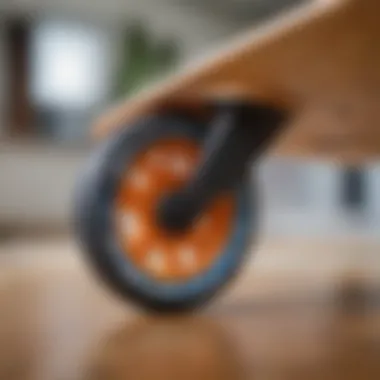

These boards often have a wider deck for stability, while their softer wheels allow for better grip without losing that easy maneuverability. Riders benefit from boards that offer a very carved shape—these can be perfect for making precision turns and enjoying the sensation of leaning into each curve.
A carving ride is akin to finding a harmonious balance between speed and control. It caters to those who cherish the rhythmic movements of skating, turning what could be a mundane commute into an exhilarating journey.
"Choosing the right type of longboard can take your riding experience from ordinary to extraordinary. Whether you seek thrills or relaxation, there’s a longboard type tailored for you."
Key Features to Consider
When diving into the world of longboarding, understanding the key features is akin to knowing the heartbeat of the sport itself. These elements not only shape the overall performance of the longboard but also determine the rider's experience—from the speed at which one can cruise down a hill to the stability during those sharp turns in a crowded park. With each longboard offering distinct qualities, it’s crucial to grasp these features to select the right ride.
Deck Material and Construction
The material and construction of a longboard's deck are foundational to its performance. Longboards can be found made from various types of wood, like maple or bamboo, each lending its own characteristics. Maple, known for durability and stiffness, creates a responsive ride, while bamboo offers lightweight flexibility and some natural shock absorption.
In addition to the wood type, the construction method matters. Some decks are made with multiple layers, providing toughness and rigidity, which can enhance stability at high speeds. Others are single, composite layers that might appeal to those seeking lighter options for tricks or commuting.
Riders need to consider their usual terrain and riding style since a well-constructed deck can drastically alter how a rider interacts with the road. A sturdy deck will be more forgiving on rougher terrains, whereas a lighter, more flexible deck can be more fun for casual rides.
Wheel Size and Durometer
Wheel specifications carry great significance, often being a determining factor for both performance and ride comfort. Wheel size typically ranges from 65mm to 75mm, and both size and durometer (the hardness of the wheel) work together to define how a longboard behaves on various surfaces.
Larger wheels—over 70mm—are ideal for rolling over cracks and bumps. These wheels provide a smoother experience when cruising or downhill riding. On the contrary, smaller wheels could prove advantageous for tricks or when speed isn’t the primary concern.
Durometer ratings, marked on a scale from 78A (soft) to 101A (hard), further impact the ride. Softer wheels grip surfaces better, making them perfect for downhill and freeride variants, while harder wheels may slide easier, which is a plus for more advanced riders looking to master slides.
Trucks and Turning Radius
Trucks, the metal parts that hold the wheels to the board, are crucial for maneuverability. They significantly influence the rider's ability to turn and manage speed. An ideal turning radius depends on the truck's width and the angle at which it’s designed. Wider trucks tend to provide stability, which can be beneficial for downhill riding or cruising at speed.
On the flip side, narrow trucks may foster quick turns, which is great for navigating through tight spaces in urban environments or performing tricks. Riders might also want to consider the material used in the trucks—aluminum is common for its durability, while steel offers added strength but is heavier.
Length and Width of the Deck
Finally, the length and width of a longboard's deck play significant roles in rider comfort and stability. Longboards generally range from 33 to 60 inches long. A longer deck typically provides better stability, which can be reassuring for those getting into downhill longboarding or for riders who seek a smoother ride. Meanwhile, shorter boards can be more nimble and easier to carry, benefitting urban riders who must navigate crowded sidewalks.
The width also affects stability; wider boards provide a more secure stance and can carry wider feet comfortably. However, if the board is too wide, it may limit foot movement and maneuverability, potentially stifling more ambitious riding styles like tricks or sharp turns.
"Choosing a longboard is like selecting a partner for a dance; it’s all about their ability to move seamlessly with you through curves and straightaways alike."
In essence, understanding these key features allows riders to tailor their longboarding experience to fit their unique style, preferences, and environment. Whether one marches down a quiet street or races towards the nearest hill, the right longboard can elevate one’s ride into something exceptional.
Top Longboard Recommendations
When it comes to selecting a longboard that fits your style and needs, checking out top recommendations makes the process easier and more enjoyable. With the growing popularity of longboarding, numerous options are out there, and it can feel like looking for a needle in a haystack. This section presents some of the best choices, catering to different preferences and budgets. The focus here is not just on brand names but on performance, materials, and the overall riding experience, ensuring that you'll find a longboard that suits your lifestyle.
Best Budget Longboards
For those who are just starting out or are looking to save a few bucks, finding a good budget longboard is key. These boards provide decent quality without breaking the bank, making them perfect for novices or those who ride casually. Options to consider for budget-friendly longboards include:
- Atom Drop Through Longboard: This is a solid choice with a low center of gravity, making it easier for beginners. It balances good performance with affordability, which many riders appreciate.
- Merlin Freestyle Longboard: While it has a unique design, it also offers excellent maneuverability at a reasonable price point, ideal for cruising through urban landscapes.
Overall, budget longboards can serve you well while you find your footing, allowing you to enjoy the thrill of riding without excess costs.
Premium Longboards
For seasoned riders or those looking to invest in a top-tier experience, premium longboards present extraordinary craftsmanship and advanced features. Investing in premium boards often means better materials, designs, and performance. Noteworthy options include:
- Loaded Boards Dervish Sama: Scratch-resistant bamboo and a lightweight build lead to a responsive ride perfect for pumping, carving, and cruising.
- Land Yachtz Switchblade: Renowned for its stability at high speeds, this board offers various flex options and is built for downhill rides.


Premium selections tend to provide durability and enhanced riding experience, allowing riders to push their limits safely.
Longboards for Beginners
Newcomers to longboarding need boards that are forgiving, supportive, and easy to handle. A forgiving setup allows beginners to build confidence. Here are some great picks:
- Retrospec Zed Bamboo Longboard: Exhibiting a beautiful design, this board is perfect for those just stepping into the world of longboarding, combining comfort with style.
- Quest Super Cruiser: With its wide deck and stable wheels, this board offers a smooth ride, making learning process less daunting.
Choosing beginner-oriented boards helps lift the intimidation factor, promoting growth in skills while having a good time.
Advanced Longboarding Options
For the longboarding aficionados ready to take on challenging tricks or speed runs, advanced longboards offer features that cater to specific riding disciplines. Riders can explore:
- Sector 9 Lookout: A well-rounded board great for freeriding or downhill pursuits, it has a good flex and stability.
- Arbor Axis: This board features a drop-through design for easy foot placement and precise control, suitable for more experienced riders.
Advanced options dramatically enhance what riders can do, helping them dominate the longboarding scene with confidence.
"Choosing the right longboard isn’t just about looks; it’s about finding the one that resonates with your riding style and offers the most enjoyment."
In summary, recommendations in each category help cater to a spectrum of riders, ensuring that everyone can find a longboard that aligns with their skills, experiences, and budget. Each board brings something different to the table, making it crucial to pick the one that suits your preferences best. This way, you'll hit the pavement ready to ride in style.
Maintenance Tips for Your Longboard
Caring for your longboard isn't just about keeping it clean; it's an essential part of ensuring safety and longevity. Whether you’re a seasoned rider or just starting out, understanding how to maintain your longboard can drastically affect your ride's performance and safety. Neglect can lead to a myriad of problems, making it vital to incorporate maintenance into your regular routine.
Regular Inspections and Adjustments
First things first: regular inspections are crucial, akin to checking the oil in your vehicle. But it doesn’t have to be a chore. As you ride, keep an eye out for any unusual noises coming from your wheels or trucks. Are you hearing a weird squeak when you carve? That could indicate that it’s high time for an adjustment. Check for wear and tear, especially on the wheels and bearings. A few signs that indicate your board might need attention include uneven wheel wear or loose trucks.
Rolling with loose trucks can make for a scary ride. A simple adjustment can usually tighten them up, restoring your control. Just a quarter turn can make a world of difference. If you notice that your trucks are so tight that they won’t turn, loosen those up a bit. The right amount of tightness is key—think of it like finding the perfect fit for your favorite pair of shoes.
Cleaning Your Longboard
Cleaning isn’t just about aesthetic appeal; it plays a significant role in performance too. Over time, dust, dirt, and grime can build up, especially around the wheels and bearings, affecting your speed and smoothness.
To keep things in tip-top shape, here’s a straightforward cleaning routine:
- Wheels: Remove them using a wrench and give them a good scrub with soap and water. For stubborn dirt, a toothbrush can work wonders.
- Deck: Wipe it down with a damp cloth. If it’s particularly dirty, a little bit of wood cleaner can help but avoid soaking the board.
- Trucks and Bearings: A quick rinse followed by a close inspection. Ensure the bearings are well-lubricated with either skateboard-specific oil or good ol’ WD-40.
"Regular cleaning can be the difference between a smooth glide and a bumpy ride!"
When to Replace Parts
Knowing when to replace parts on your longboard can save you from an unexpected spill or injury. Typically, wheels and bearings are the first to bear the brunt. If you can press a fingernail into the wheel and leave a dent, it's probably time to swap them out.
Consider the following when evaluating whether to replace parts:
- Wheels: If they’re chipped or noticeably misshapen, they might need to be replaced to maintain grip and speed.
- Bearings: If you’ve cleaned them but they still lack a good spin or make a grinding noise, it’s best to install new ones.
- Deck: Scratches and dents might not matter aesthetically, but if they compromise the integrity of the wood, don’t hesitate to replace it.
Routine diligence with small replacements can extend the life of your longboard significantly. While it might seem like a small hassle, your future self will thank you later when you're cruising down the street without a care in the world.
Longboarding Technique and Safety
Longboarding is not just about cruising down a hill or showing off tricks. It's an intricate dance between rider skill, board control, and, perhaps most crucially, safety awareness. Developing a solid foundation in longboarding techniques can make all the difference in enjoying the ride without a hitch. While many enthusiasts often prioritize flashy maneuvers, it’s essential to focus on the basics and ensure that safety is always a top priority. This section is where we dive into these pivotal aspects.
Basic Riding Techniques
Before hitting the pavement, let's break down some of the core techniques every longboarder should master. These are like the bread and butter of longboarding — essential for anyone who wants to ride smoothly and safely.
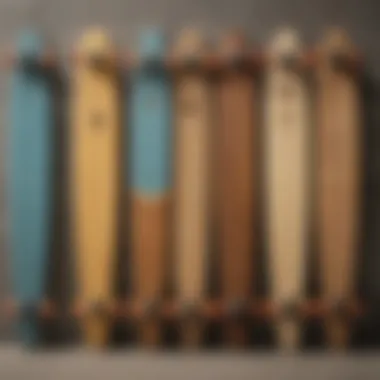

- Foot Placement: Your foot positioning on the deck shapes how you react to turns and stops. The front foot should be centered, providing balance, while the back foot should comfortably rest at the tail for control.
- Pushing Off: To get moving, push off with your back foot while keeping the front foot firmly on the board. This step may sound mundane, but getting it right is crucial for a smooth start.
- Turning: To steer, shift your weight onto your heels or toes, leaning slightly in the direction you want to go. This shifting helps initiate a turn without excessive force. Think of it like leaning into a curve while riding a bicycle — it feels natural once you get the hang of it.
- Stopping: Learning to stop is non-negotiable. The easiest technique for beginners is the foot brake, where you drag your back foot on the ground gently. It’s all about controlling your speed and coming to a safe halt without a dramatic jolt.
- Carving: Once you have the basics down, improving your carving skills adds agility to your ride. Carving involves smoothly weaving back and forth, shifting your weight from side to side, which not only enhances your control but also builds momentum.
It's imperative to practice these techniques in a safe environment before venturing into busier areas. A parking lot on a calm day can be an ideal training ground.
Mastering these fundamental techniques provides a strong foundation for more advanced maneuvers, increasing the enjoyment of longboarding while minimizing risks.
Safety Gear and Its Importance
Considering safety gear often seems like an afterthought, but it can be the difference maker between a fun experience and a trip to the hospital. Longboarding has its thrills and spills, and safeguarding oneself is paramount. Here’s a rundown of essential gear to consider:
- Helmet: This is non-negotiable. A good helmet can protect against serious head injuries. Choose a model that fits snugly and meets safety certifications.
- Knee and Elbow Pads: These pads can reduce the impact during falls, especially for those just starting or trying new tricks. They’re less about looking cool and more about protecting your joints from inevitable tumbles.
- Wrist Guards: Falls often lead to instinctively reaching out with your hands. Wrist guards can help prevent sprains and breaks, thereby ensuring you can keep riding.
- Shoes: Invest in a pair of sturdy skate shoes. Opt for shoes with grippy soles and some ankle support for better control and stability.
- Visibility Gear: If riding at dusk or dawn, wearing bright or reflective clothing can alert drivers and increase safety.
The combination of understanding basic riding techniques and being equipped with the right safety gear is essential for any longboarder. Protecting oneself not only enhances the experience of riding but also fosters a culture of responsibility within the community. After all, it’s a lot easier to enjoy the wind in your hair when you know you're safe.
Longboarding Culture and Community
The culture of longboarding extends far beyond simply riding. It embodies a lifestyle characterized by a shared passion for an exhilarating and free-spirited experience on wheels. As longboarding has carved out its niche in the world of extreme sports, it fosters a vibrant community of riders, enthusiasts, and creators, each contributing to the culture’s rich fabric. The significance of this culture lies not only in the thrill of the ride but also in the camaraderie, creativity, and sustainability that longboarding promotes.
Benefits of Engaging with the Longboarding Community
Being a part of the longboarding community offers myriad advantages for riders, newbies, and seasoned pros alike.
- Networking Opportunities: Connecting with fellow longboard enthusiasts can lead to friendships, mentorships, and valuable advice on gear, techniques, and local spots.
- Skill Development: Riders often share tips and tricks, enabling each other to enhance their skills and mastering new techniques quicker than if they were to ride solo.
- Motivation and Inspiration: Watching proficient riders can spark motivation, pushing individuals to step outside their comfort zones and attempt new maneuvers.
- Environmental Awareness: Longboarding often promotes eco-friendly practices, highlighting choices such as sustainable materials in longboard construction and the benefits of skating as a green mode of transportation.
Events and Competitions
The world of longboarding is punctuated with events and competitions that not only challenge riders but also celebrate the community spirit. Whether it’s a local gathering of enthusiasts or an international competition like the Queen Mary’s Longboard Race in California, these events serve numerous purposes. They provide a platform for showcasing skills and styles, and also offer spectators an opportunity to witness incredible talent.
Participating in competitions or attending events also creates a sense of belonging, as riders from diverse backgrounds unite under a common interest.
Online Communities and Resources
The internet has significantly expanded the reach of the longboarding community, helping it thrive across various platforms. Online forums and social media groups on platforms such as Reddit and Facebook have become hubs for discussions on gear, techniques, and location recommendations.
- Reddit has communities like r/longboarding that facilitate discussions about everything longboard related, from sharing videos to asking for advice.
- Facebook provides numerous groups where both beginners and seasoned riders connect, share experiences, and organize local meet-ups.
Moreover, there are online resources filled with articles, videos, and tutorials that teach about maintenance, riding techniques, and the latest in longboarding news. Websites like Wikipedia and Britannica provide foundational knowledge while community platforms keep conversations lively and current.
"The longboarding community thrives on its inclusivity, bringing together riders from all walks of life to share in the joy of cruising."
As you immerse yourself in longboarding culture, remember that it’s about more than just the ride—it’s about the friendships, the progress, and the impact you can have on creating a sustainable and enjoyable experience for all.
Environmental Considerations
As the popularity of longboarding continues to rise, it's crucial to pause and reflect on the ecological footprint shaped by our riding enthusiasm. Longboarding isn’t just a sport; it embodies a lifestyle that, if conducted with care, can harmonize with our environment rather than detract from it. In this section, we’ll unravel significant facets surrounding environmental considerations in longboarding, underscoring sustainable materials and their impact on urban spaces.
Sustainable Materials in Longboarding
When it comes to longboards, the choice of materials plays a vital role not only in durability but also in environmental impact. Today, several manufacturers are acknowledging the call for sustainability, opting for eco-conscious materials. For instance, using bamboo or reclaimed wood instead of traditional hardwood significantly reduces tree harvesting, thereby protecting forests.
Beyond wood, bio-resins and recycled plastics are gaining traction. These alternatives minimize the carbon footprint associated with the production of conventional fiberglass or polyurethane boards. Additionally, choosing brands that prioritize sustainability can steer the industry towards more responsible practices.
- Bamboo: Strong and flexible, bamboo grows rapidly, making it a renewable option for skateboard decks.
- Reclaimed Wood: Utilizes materials that might otherwise go to waste, giving longboards a unique character.
- Eco-friendly Manufacturing: Brands like Landyachtz emphasize reducing emissions in their production processes, leading to a smaller ecological impact.
The broader conversation often extends into the realm of consumer habits as well. Opting to purchase from manufacturers who are committed to sustainable practices encourages a shift in the market, urging more companies to follow suit.
Impact of Longboarding on Urban Spaces
As urbanization continues to march forward, longboarding increasingly finds its place in the concrete jungles we navigate daily. The impact can be multifaceted, offering both benefits and considerations.
Longboarding promotes a slower, more sustainable mode of mobility compared to cars or motorbikes, reducing traffic congestion and emissions. For instance, commuters may find themselves zipping through city streets on a longboard effortlessly, contributing to a greener urban environment. Additionally, the vibrant culture surrounding longboarding encourages community engagement and the revitalization of public spaces. This spirit can transform dreary streets into lively hubs for creativity, exercise, and social interaction.
However, this increased presence also raises concerns around safety and urban infrastructure. Cities are challenged to adapt, creating more bike lanes and safer paths that cater to skateboarders. Improperly managed rides can lead to accidents, and without adequate space designed for such activities, conflicts with pedestrians can arise.
"Sustainable living isn’t a destination, but a journey we all can embark on, one push at a time."
In summary, recognizing and addressing environmental considerations is imperative for longboard enthusiasts driven by both passion and responsibility. By choosing sustainable materials and embracing positive impacts on urban settings, riders can ensure that the legacy of longboarding continues to cultivate joy without compromising the earth we share.
